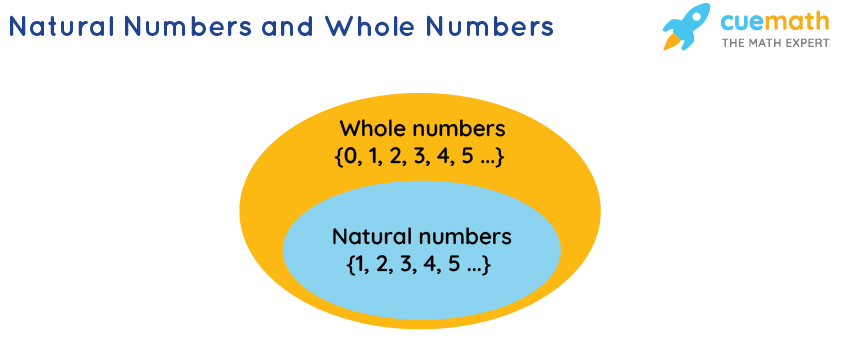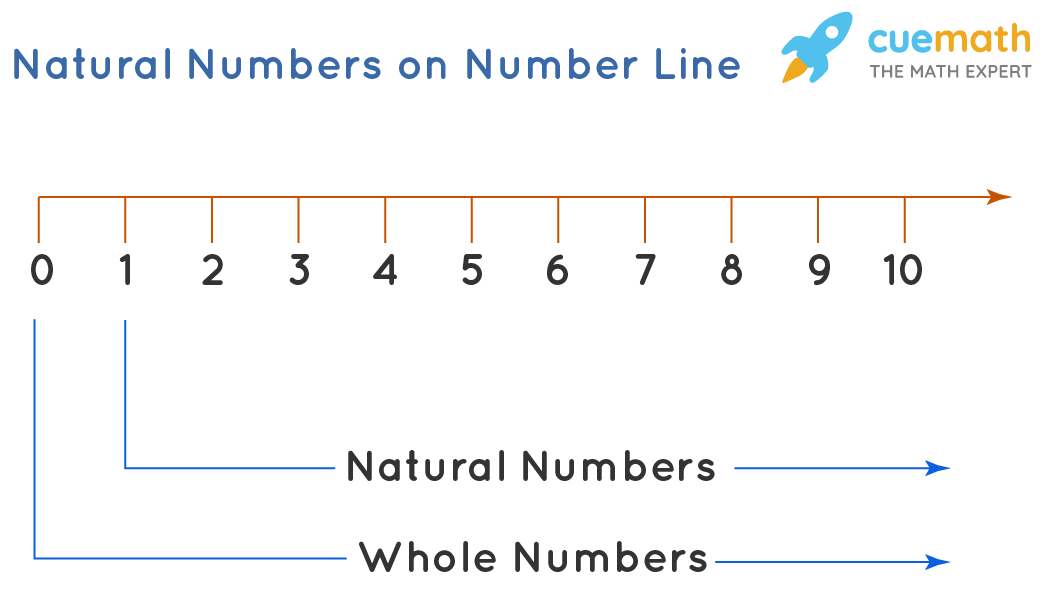Natural Numbers
Natural numbers are a part of the number system, including all the positive numbers from 1 to infinity. Natural numbers are also known as counting numbers because they do not include zero or negative numbers. They are a part of real numbers including only the positive integers, but not zero, fractions, decimals, and negative numbers. Let us learn about the natural numbers definition and natural number examples on this page.
What are Natural Numbers?
Natural numbers refer to a set of all the whole numbers excluding 0. These numbers are significantly used in our day-to-day activities. We see numbers everywhere around us, for counting objects, representing or exchanging money, for measuring the temperature, telling the time, etc. These numbers that are used for counting objects are called 'natural numbers'. For example, while counting objects, we say 5 cups, 6 books, 1 bottle, and so on.
Natural Numbers Definition
Natural numbers are the numbers that are used for counting and are a part of real numbers. The set of natural numbers includes only the positive integers, i.e., 1, 2, 3, 4, 5, 6, ……….∞.
Examples of Natural Numbers
A few examples of natural numbers are 23, 56, 78, 999, 100202, and so on.
Set of Natural Numbers
A set is a collection of elements (numbers in this context). The set of natural numbers in Mathematics is written as {1,2,3,...}.
Natural Numbers Symbol
The set of natural numbers is denoted by the symbol, N. So, the set of natural numbers is represented as N = {1,2,3,4,5,...∞}
| Statement Form | N = Set of all numbers starting from 1. |
|---|---|
| Roaster Form | N = {1, 2, 3, 4, 5, 6, 7, 8, 9, 10, ………………………………} |
| Set Builder Form | N = {x : x is an integer starting from 1} |
Smallest Natural Number
The smallest natural number is 1. We know that the smallest element in N is 1. This means natural numbers start from 1 and go on till infinity.
Natural Numbers from 1 to 100
The natural numbers from 1 to 100 are 1, 2, 3, 4, 5, 6, 7, 8, 9, 10, 11, 12, 13, 14, 15, 16, 17, 18, 19, 20, 21, 22, 23, 24, 25, 26, 27, 28, 29, 30, 31, 32, 33, 34, 35, 36, 37, 38, 39, 40, 41, 42, 43, 44, 45, 46, 47, 48, 49, 50, 51, 52, 53, 54, 55, 56, 57, 58, 59, 60, 61, 62, 63, 64, 65, 66, 67, 68, 69, 70, 71, 72, 73, 74, 75, 76, 77, 78, 79, 80, 81, 82, 83, 84, 85, 86, 87, 88, 89, 90, 91, 92, 93, 94, 95, 96, 97, 98, 99 and 100.
Is 0 a Natural Number?
No, 0 is NOT a natural number because natural numbers are counting numbers. For counting any number of objects, we start counting from 1 and not from 0.

Odd Natural Numbers
The odd natural numbers are the numbers that are odd and belong to the set N. So the set of odd natural numbers is {1,3,5,7,...}.
Even Natural Numbers
The even natural numbers are the numbers that are even, which means the natural numbers that are completely divisible by 2, and belong to the set N. So the set of even natural numbers is {2,4,6,8,...}.
Natural Numbers and Whole Numbers
The set of whole numbers is the same as the set of natural numbers, except that it includes an additional number which is 0. The set of whole numbers in Mathematics is written as {0,1,2,3,...}. It is denoted by the letter, W.
W = {0,1,2,3,4…}
From the above definitions, we can understand that every natural number is a whole number. Also, every whole number other than 0 is a natural number. We can say that the set of natural numbers is a subset of the set of whole numbers.

Difference Between Natural Numbers and Whole Numbers
Natural numbers are all positive numbers like 1, 2, 3, 4, and so on. They are the numbers you usually count and they continue till infinity. Whereas, whole numbers are all natural numbers including 0, for example, 0, 1, 2, 3, 4, and so on. Integers include all whole numbers and their negative counterpart. e.g, -4, -3, -2, -1, 0,1, 2, 3, 4 and so on. The following table shows the difference between a natural number and a whole number.
| Natural Number | Whole Number |
|---|---|
| The set of natural numbers is N= {1,2,3,...∞} | The set of whole numbers is W={0,1,2,3,...} |
| The smallest natural number is 1. | The smallest whole number is 0. |
| All natural numbers are whole numbers, but all whole numbers are not natural numbers. | Each whole number is a natural number, except zero. |
Natural Numbers on Number Line
The set of natural numbers and whole numbers can be shown on the number line as given below. All the positive integers or the integers on the right-hand side of 0, represent the natural numbers, whereas, all the positive integers along with zero, represent the whole numbers.

Properties of Natural Numbers
The four operations, addition, subtraction, multiplication, and division, on natural numbers, lead to four main properties of natural numbers as shown below:
- Closure Property
- Associative Property
- Commutative Property
- Distributive Property
Let us read about these properties in detail.
Closure Property
The sum and product of two natural numbers is always a natural number. This property applies to addition and multiplication but is not applicable to subtraction and division.
- Closure Property of Addition: a + b = c ⇒ 1 + 2 = 3, 7 + 8 = 15. This shows that the sum of natural numbers is always a natural number.
- Closure Property of Multiplication: a × b = c ⇒ 2 × 3 = 6, 7 × 8 = 56, etc. This shows that the product of natural numbers is always a natural number.
Associative Property
The sum or product of any three natural numbers remains the same even if the grouping of numbers is changed. This property applies to addition and multiplication but is not applicable to subtraction and division.
- Associative Property of Addition: a + (b + c) = (a + b) + c ⇒ 2 + (3 + 1) = 2 + 4 = 6 and the same result is obtained in (2 + 3) + 1 = 5 + 1 = 6.
- Associative Property of Multiplication: a × (b × c) = (a × b) × c ⇒ 2 × (3 × 1) = 2 × 3 = 6 and the same result is obtained in (a × b) × c = (2 × 3) × 1 = 6 × 1 = 6.
Commutative Property
The sum or product of two natural numbers remains the same even after interchanging the order of the numbers. This property applies to addition and multiplication but is not applicable to subtraction and division.
- Commutative Property of Addition: a + b = b + a ⇒ 8 + 9 = 17 and b + a = 9 + 8 = 17.
- Commutative Property of Multiplication: a × b = b × a ⇒ 8 × 9 = 72 and 9 × 8 = 72.
Distributive Property
The distributive property is known as the distributive law of multiplication over addition and subtraction. It states that an expression that is given in form of a (b + c) can be solved as a × (b + c) = ab + ac. This distributive law which is also applicable to subtraction is expressed as, a (b - c) = ab - ac. This means operand 'a' is distributed between the other two operands.
- The distributive property of multiplication over addition is a × (b + c) = (a × b) + (a × c)
- The distributive property of multiplication over subtraction is a × (b - c) = (a × b) - ( a × c)
First 10 Natural Numbers
Natural numbers are counting numbers that start from 1. So, the first 10 natural numbers are 1, 2, 3, 4, 5, 6, 7, 8, 9, and 10.
Important Points
- 0 is not a natural number, it is a whole number.
- Negative numbers, fractions, and decimals are neither natural numbers nor whole numbers.
☛ Related Articles
- Prime Numbers
- Composite Numbers
- Rational Numbers
- Irrational Numbers
- Properties of Natural Numbers
- LCM of First 10 Natural Numbers
- Natural Numbers Addition Calculator
Cuemath is one of the world's leading math learning platforms that offers LIVE 1-to-1 online math classes for grades K-12. Our mission is to transform the way children learn math, to help them excel in school and competitive exams. Our expert tutors conduct 2 or more live classes per week, at a pace that matches the child's learning needs.
Natural Number Examples
-
Example 1: Identify the natural numbers among the following numbers: -1, 0, 3, 1/2, 5.
Solution:
The set of natural numbers in Mathematics is the set {1, 2, 3, ...}. Now, -1 is a negative number, so it is not a natural number. 0 is also not a natural number. 1/2, being a fractional number, is not a natural number, either. Therefore, among the given numbers, the natural numbers are 3 and 5.
-
Example 2: Fill in the blanks with respect to natural numbers.
a.) Natural numbers start from _
b.) _ is a whole number which is not a natural number.
c.) Write the natural numbers from 2 to 12
Solution:
a.) Natural numbers start from 1
b.) 0 is a whole number which is not a natural number.
c.) The natural numbers from 2 to 12 can be listed as follows: 2, 3, 4, 5, 6, 7, 8, 9, 10, 11, 12
-
Example 3: State true or false with respect to natural numbers.
a.) 0 is a natural number.
b.) Every natural number is a whole number.
c.) All natural numbers are integers.
Solution:
a.) False, 0 is not a natural number. It is a whole number.
b.) True, every natural number is a whole number because whole numbers include all positive counting numbers starting from 0.
c.) True, all natural numbers are integers because integers include all positive numbers, all negative numbers and zero.

FAQs on Natural Numbers
What are Natural Numbers in Maths?
Natural numbers are the numbers that start from 1 and end at infinity. In other words, natural numbers are counting numbers and they do not include 0 or any negative or fractional numbers. For example, 1, 6, 89, 345, and so on, are a few examples of natural numbers.
What is the Sum of the First 10 Natural Numbers?
The first 10 natural numbers are 1, 2, 3, 4, 5, 6, 7, 8, 9, 10 and their sum is 1 + 2 + 3 + 4 + 5 + 6 + 7 + 8 + 9 + 10 = 55
How many Natural Numbers are there?
Natural numbers are counting numbers that start from 1 and go on till infinity. Therefore, there are infinite natural numbers.
How are Natural Numbers Different from Whole Numbers?
The following points show the difference between natural numbers and whole numbers.
- Natural numbers are all counting numbers like 1, 2, 3, 4, and so on. Whereas, whole numbers are all natural numbers including 0, for example, 0, 1, 2, 3, 4, and so on.
- All natural numbers are whole numbers, but all whole numbers are not natural numbers.
- The smallest natural number is 1, whereas, the smallest whole number is 0.
What are the Four Basic Properties of Natural Numbers in Math?
The four basic properties of natural numbers in math are given below. A detailed explanation of these properties is given above on this page:
- Closure property
- Associative property
- Commutative property
- Distributive property
What is an Example of a Natural Number?
A few examples of natural numbers can be listed as 1, 2, 3, 4, 5, and so on.
Is 23 a Natural Number?
Yes, 23 is a natural number because it is a positive number that is used in counting.
Why are Natural Numbers Called Natural?
Natural numbers are called natural because they are used for counting naturally. The set of natural numbers is the most basic system of numbers because it is intuitive, or natural, and hence the name. We use natural numbers in our everyday life, in counting discrete objects, that is, objects which can be counted.
What are the First Five Natural Numbers?
Natural numbers are the numbers that are used for counting and are a part of real numbers. The first five natural numbers are 1, 2, 3, 4, and 5.
How to Find the Sum of n Natural Numbers?
To find the sum of 'n' natural numbers, we use the formula: Sum= n(n + 1)/2, where 'n' represents the number of terms. For example, if we want to find the sum of the first six natural numbers: 1, 2, 3, 4, 5, 6, we will replace 'n' with 6 (the total number of terms) and solve the formula. Sum= n(n + 1)/2. This means 6(6 + 1)/2 = 42/2 = 21. We get 21 as the answer.
Why are all Natural Numbers Integers?
Integers are the numbers that form the set of negative and positive numbers, including zero, and the positive numbers come under the category of natural numbers. Thus, all natural numbers are integers.
Write the Next Three Natural Numbers After 10999.
The next three natural numbers after 10999 are 11000, 11001 and 11002.
What is the Greatest Natural Number?
Since natural numbers go on till infinity, the largest natural number cannot be stated.
Is 0 a Natural Number?
No, 0 is not a natural number. Natural numbers start from 1 and can be listed as 1, 2, 3, 4, 5, and so on. However, 0 comes under the category of whole numbers and integers.
What is the Smallest Natural Number?
The smallest natural number is 1 because natural numbers are counting numbers that start from 1.
Where do Natural Numbers Start from?
Natural Numbers start from 1 and go on till infinity. They are positive counting numbers and do not include 0.
visual curriculum